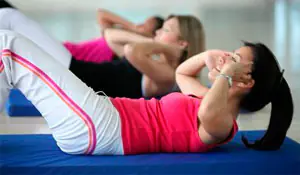Let's give a general idea about work of the main muscles in the most characteristic movements, with the help of which they can be influenced. Strength exercises can be either general or local, aimed at individual muscle groups.
I. Neck muscles.
Tilt your head forward to the sides. Turns left and right. Typical exercises: tilting the head forward, to the sides, turning the head, circular movements of the head, standing or walking.
II. Main muscle groups of the upper limbs.
Movement of the upper limbs is produced by muscles:
- forward - pectoral (major and minor), serratus anterior;
- back - trapezius, rhomboid (major and minor), latissimus dorsi;
- up - the upper bundles of the trapezius muscle, the rhomboid muscle, the levator scapula, the sternocleidomastoid muscle;
- down - pectoralis minor, subclavian.
Muscles that move the shoulder joint:
- shoulder abduction - deltoid and supraspinatus;
- shoulder adduction - infraspinatus, teres minor, subscapularis;
- shoulder flexion - deltoid, pectoralis major, biceps brachii.
III. Musculature of the trunk.
Muscles that produce movements of the spinal column:
- extension - trapezius, serratus posterior (superior and inferior), splenius muscles of the neck and head;
- flexion - rectus abdominis and oblique muscles, iliopsoas, sternocleidomastoid, longus capitis and neck muscles.
- Exercises for the muscles of the shoulder girdle:
- Exercises for the torso (abdomen and back groups):
- Exercises for leg muscles:
- Use of simulators
Exercises for the muscles of the shoulder girdle:
- Starting position - on the spot or while walking, rotation of the arms: simultaneous, alternate, alternating and sequential in the shoulder, elbow and wrist joints.
- Bending/extension of arms in support, moving on hands with the help of a partner.
- Starting position - lying on your back, bringing and spreading your arms in different planes.
- Starting position - standing still, with one hand reaching the other behind your back in different planes.
- Pull-up on the bar.
- Starting position – standing upright, with your feet shoulder-width apart, bend your torso forward, backward and to the sides.
- The initial position is the same, turns and rotations of the torso.
- Starting position - lying on the floor, arms or legs secured - lifting the torso or legs.
- Exercises on the gymnastic wall.
IV. Muscle groups of the lower extremities.
The muscles that produce hip flexion in the hip joint include: iliopsoas, sartorius, rectus femoris, pectineus;
- extension - gluteus maximus, biceps, adductor magnus, semitendinosus; abduction - gluteus medius and minimus, piriformis, internal obturator;
- adduction - comb, thin long, short and adductus magnus;
- supination - iliopsoas, gluteal, sartorius, twin;
- pronation - the anterior bundles of the gluteus medius and minimus muscles.
Muscles - flexors of the leg: biceps femoris, semitendinosus, popliteal, gastrocnemius, sartorius;
The quadriceps femoris muscle is involved in leg extension.
Muscles that produce foot movement: flexion - triceps surae, plantar, peroneus long/short, tibialis posterior, flexor digitorum longus, flexor pollicis longus;
extension - tibialis anterior, extensor digitorum longus.
Exercises for leg muscles:
- Starting position - standing with your hands up against the barrier, alternately swinging a straight and bent leg longitudinally and transversely.
- Starting position - standing still, alternating lunges with the left and right legs longitudinally and transversely with the addition of springy swaying; walking in lunges with a slow increase in step length to a maximum; the same with the use of jumps.
- Starting position - standing in a half-squat, deep squatting and standing on one or two legs at different paces and stopping in different positions.
- Starting position - standing on a gymnastic bench, jumping from different heights onto both legs at once (or on one leg) and then jumping up and forward.
- Jumping and jumping from a half-squat, jumping on two (or on one leg) while standing still and directly in motion, running.
- Grasping objects with your toes, moving barefoot by flexing and extending your toes, flexion and extension, supination and pronation of each foot.
- standing - bending forward, backward, to the sides;
- rotations and turns to the side;
- squats;
- various jumps;
- presses, jerks, jerks;
- in motion - walking, running, walking with lunges, walking with side and cross steps;
- lying down - raising and moving your arms back, to the sides, etc.
Use of simulators
Performing strength exercises on training devices and machines has a number of advantages over traditional means (barbell and other weights):
- the intensity and emotionality of the educational process significantly increases;
- Compared to exercises with a barbell, more exercises are performed in a lying position, in which position the load on the spine is eliminated;
- simulators locally influence various muscle groups, including those that have less opportunity for improvement during the training process;
- contribute to clear programming of the structure of movements, as well as the nature and magnitude of the specific load;
- allow movements in various projections and modes of muscle operation;
- allow you to take into account the individual characteristics of the strength training of each athlete.
The exercises we discussed in this article for different muscle groups are suitable and shown to almost all people. They are uncomplicated, accessible and easy to use. Can be used by athletes of various ages, as well as schoolchildren and students to strengthen their physical fitness. And the use of simulators significantly increases the intensity of the educational and training process of athletes of various levels of training and orientation.
Post Views: 107


